Magnetically Separable Chiral Poly(ionic liquid) Microcapsules Prepared Using Oil-in-Oil Emulsions
Abstract
:1. Introduction
2. Materials and Methods
2.1. General Information
2.2. Preparation of 3-Butyl-1-[3-(Trimethoxysilyl)Propyl]-1H-Imidazol-3-Ium Chloride (IL-C4) [43]
2.3. Preparation of Magnetite Nanoparticles Modified with IL-C4 (MNPs-IL-C4) [43]
2.4. Preparation of Tert-Butyl N-(3-Chloropropyl)Carbamate [44]
2.5. Preparation of Tert-Butyl (3-(1H-Imidazol-1-Yl)Propyl)Carbamate [45]
2.6. Preparation of 1,3-Bis(3-((Tert-Butoxycarbonyl)Amino)Propyl)-1H-Imidazol-3-Ium Chloride (BAPIC) [46]
2.7. Preparation of 1,3-Bis(3-Aminopropyl)-1H-Imidazol-3-Ium-2,7-Dioxo-3,8-Diphenyl-1,4,6,9-Tetraoxa-5-Boraspiro [4.4] Nonan-5-Uide (IL-NH2-BMB)
2.8. Preparation of Magnetically Separable Chiral Polyurea Microcapsules
2.9. Adsorption of Tryptophan (Trp) on the Magnetic Chiral Polyurea Microcapsules
3. Results and Discussion
3.1. Preparation and Characterization of Magnetite Nanoparticles Modified by Ionic Liquid (MNPs-IL-C4)
3.2. Preparation and Characterization of a Chiral Ionic Liquid-Based Diamine Monomer (IL-NH2-BMB)
3.3. Preparation and Characterization of Magnetically Separable Chiral Poly(ionic liquid) Microcapsules
3.4. Enantioselective Adsorption of Tryptophan Enantiomers by Magnetically Separable Chiral Poly(ionic liquid) Microcapsules
4. Conclusions
Supplementary Materials
Author Contributions
Funding
Data Availability Statement
Acknowledgments
Conflicts of Interest
References
- Eliel, E.L.; Wilen, S.H. Stereochemistry of Organic Compounds; John Wiley and Sons: New York, NY, USA, 1994. [Google Scholar]
- Subramanian, G. (Ed.) Chiral Separation Techniques: A Practical Approach; Wiley-VCH: Weinheim, Germany, 2001. [Google Scholar]
- Gruttadauria, M.; Giacalone, F. (Eds.) Catalytic Methods in Asymmetric Synthesis; John Wiley & Sons: Hoboken, NJ, USA, 2011. [Google Scholar]
- Sheldon, R.A. Chirotechnology: Designing Economic Chiral Syntheses. J. Chem. Technol. Biotechnol. 1996, 67, 1–14. [Google Scholar] [CrossRef]
- Fda’s Policy Statement for the Development of New Stereoisomeric Drugs. Chirality 1992, 4, 338–340. [CrossRef] [PubMed]
- Collins, A.N.; Sheldrake, G.N.; Crosby, J. (Eds.) Chirality in Industry II: Developments in the Commercial Manufacture and Applications of Optically Active Compounds; John Wiley & Sons: New York, NY, USA, 1997. [Google Scholar]
- Kurihara, N.; Miyamoto, J. (Eds.) Chirality in Agrochemicals; John Wiley & Sons: New York, NY, USA, 2003. [Google Scholar]
- Farina, V.; Reeves, J.T.; Senanayake, C.H.; Song, J.J. Asymmetric Synthesis of Active Pharmaceutical Ingredients. Chem. Rev. 2006, 106, 2734–2793. [Google Scholar] [CrossRef] [PubMed]
- Nguyen, L.A.; He, H.; Chuong, P.-H. Chiral Drugs. An Overview. Int. J. Biomed. Sci. 2006, 2, 85–100. [Google Scholar] [PubMed]
- Yamamoto, H.; Carreira, E. (Eds.) Comprehensive Chirality; Elsevier Inc.: Amsterdam, The Netherlands, 2012. [Google Scholar]
- Harris, K.D.M.; Thomas, S.J.M. Selected Thoughts on Chiral Crystals, Chiral Surfaces, and Asymmetric Heterogeneous Catalysis. ChemCatChem 2009, 1, 223–231. [Google Scholar] [CrossRef]
- Marx, S.; Avnir, D. The Induction of Chirality in Sol-Gel Materials. Acc. Chem. Res. 2007, 40, 768–776. [Google Scholar] [CrossRef]
- Mastai, Y. Enantioselective Crystallization on Nanochiral Surfaces. Chem. Soc. Rev. 2009, 38, 772–780. [Google Scholar] [CrossRef]
- Morris, R.E.; Bu, X. Induction of Chiral Porous Solids Containing Only Achiral Building Blocks. Nat. Chem. 2010, 2, 353–361. [Google Scholar] [CrossRef]
- Paik, P.; Gedanken, A.; Mastai, Y. Chiral-Mesoporous-Polypyrrole Nanoparticles: Its Chiral Recognition Abilities and Use in Enantioselective Separation. J. Mater. Chem. 2010, 20, 4085–4093. [Google Scholar] [CrossRef]
- Paik, P.; Mastai, Y.; Kityk, I.; Rakus, P.; Gedanken, A. Synthesis of Amino Acid Block-Copolymer Imprinted Chiral Mesoporous Silica and Its Acoustically-Induced Optical Kerr Effects. J. Solid State Chem. 2012, 192, 127–131. [Google Scholar] [CrossRef]
- Raval, R. Chiral Expression from Molecular Assemblies at Metal Surfaces: Insights from Surface Science Techniques. Chem. Soc. Rev. 2009, 38, 707–721. [Google Scholar] [CrossRef] [PubMed]
- Song, C.; Liu, X.; Liu, D.; Ren, C.; Yang, W.; Deng, J. Optically Active Particles of Chiral Polymers. Macromol. Rapid Commun. 2013, 34, 1426–1445. [Google Scholar] [CrossRef] [PubMed]
- Wang, Y.; Xu, J.; Wang, Y.; Chen, H. Emerging Chirality in Nanoscience. Chem. Soc. Rev. 2013, 42, 2930–2962. [Google Scholar] [CrossRef]
- Yoon, M.; Srirambalaji, R.; Kim, K. Homochiral Metal-Organic Frameworks for Asymmetric Heterogeneous Catalysis. Chem. Rev. 2012, 112, 1196–1231. [Google Scholar] [CrossRef] [PubMed]
- Medina, D.D.; Mastai, Y. Chiral Polymers and Polymeric Particles for Enantioselective Crystallization. Isr. J. Chem. 2018, 58, 1330–1337. [Google Scholar] [CrossRef]
- Nunez-Martinez, M.; Fernandez-Miguez, M.; Quinoa, E.; Freire, F. Size Control of Chiral Nanospheres Obtained Via Nanoprecipitation of Helical Poly(Phenylacetylene)S in the Absence of Surfactants. Angew. Chem. Int. Ed. 2024, 63, e202403313. [Google Scholar] [CrossRef]
- Zhang, C.H.; Liu, L.J.; Okamoto, Y. Enantioseparation Using Helical Polyacetylene Derivatives. Trac-Trends Anal. Chem. 2020, 123, 115762. [Google Scholar] [CrossRef]
- Zhang, Y.J.; Huang, H.J.; Zhao, B.; Deng, J.P. Preparation and Applications of Chiral Polymeric Particles. Isr. J. Chem. 2018, 58, 1286–1298. [Google Scholar] [CrossRef]
- Zhao, B.; Deng, J.P. Emulsion Polymerization of Acetylenics for Constructing Optically Active Helical Polymer Nanoparticles. Polym. Rev. 2017, 57, 119–137. [Google Scholar] [CrossRef]
- Zhong, H.; Deng, J.P. Organic Polymer-Constructed Chiral Particles: Preparation and Chiral Applications. Polym. Rev. 2022, 62, 826–859. [Google Scholar] [CrossRef]
- Kausar, A. Research Progress in Frontiers of Poly(Ionic Liquid)S: A Review. Polym. Plast. Technol. Eng. 2017, 56, 1823–1838. [Google Scholar] [CrossRef]
- Li, Q.; Yan, F.; Texter, J. Polymerized and Colloidal Ionic Liquids-Syntheses and Applications. Chem. Rev. 2024, 124, 3813–3931. [Google Scholar] [CrossRef] [PubMed]
- Qian, W.J.; Texter, J.; Yan, F. Frontiers in Poly(Ionic Liquid)S: Syntheses and Applications. Chem. Soc. Rev. 2017, 46, 1124–1159. [Google Scholar] [CrossRef] [PubMed]
- Shaplov, A.S.; Ponkratov, D.O.; Vygodskii, Y.S. Poly(Ionic Liquid)S: Synthesis, Properties, and Application. Polym. Sci. Ser. B 2016, 58, 73–142. [Google Scholar] [CrossRef]
- Yuan, J.Y.; Mecerreyes, D.; Antonietti, M. Poly(Ionic Liquid)S: An Update. Prog. Polym. Sci. 2013, 38, 1009–1036. [Google Scholar] [CrossRef]
- Al-Sodies, S.; Asiri, A.M.; Khan, A.; Alamry, K.A.; Hussein, M.A. Recent Exploiting of Poly(Ionic Liquid)S in Sensing Applications. Eur. Polym. J. 2024, 205, 112719. [Google Scholar] [CrossRef]
- Bernardo, G.; Gaspar, H. Recent Advances in Poly(Ionic Liquid)-Based Membranes for CO2 Separation. Polymers 2023, 15, 667. [Google Scholar] [CrossRef]
- Liu, C.X.; Raza, F.; Qian, H.; Tian, X. Recent Advances in Poly(Ionic Liquid)S for Biomedical Application. Biomater. Sci. 2022, 10, 2524–2539. [Google Scholar] [CrossRef]
- Panda, I.; Samal, S.K.; Pradhan, S. A Review on Antibacterial Potential of Poly-Ionic Liquid-Based Biomaterials. J. Polym. Sci. 2024, 62, 1201–1221. [Google Scholar] [CrossRef]
- Yang, B.G.; Yang, G.J.; Zhang, Y.M.; Zhang, S.X.A. Recent Advances in Poly(Ionic Liquid)S for Electrochromic Devices. J. Mater. Chem. C 2021, 9, 4730–4741. [Google Scholar] [CrossRef]
- Zhu, M.Y.; Yang, Y. Poly(Ionic Liquid)S: An Emerging Platform for Green Chemistry. Green Chem. 2024, 26, 5022–5102. [Google Scholar] [CrossRef]
- Men, Y.J.; Kuzmicz, D.; Yuan, J.Y. Poly(Ionic Liquid) Colloidal Particles. Curr. Opin. Colloid Interface Sci. 2014, 19, 76–83. [Google Scholar] [CrossRef]
- Pothanagandhi, N.; Sivaramakrishna, A.; Vijayakrishna, K. Chiral Anion-Triggered Helical Poly(Ionic Liquids). Polym.Chem. 2017, 8, 918–925. [Google Scholar] [CrossRef]
- Wang, J.X.; Tian, Y.B.; Zhang, S.G.; Zhang, Y. Chiral Porous Poly(Ionic Liquid)S: Facile One-Pot, One-Step Synthesis and Efficient Heterogeneous Catalysts for Asymmetric Epoxidation of Olefins. Appl. Catal. Gen. 2022, 631, 118477. [Google Scholar] [CrossRef]
- Wu, D.T.; Yu, Y.; Zhang, J.; Guo, L.L.; Kong, Y. Chiral Poly(Ionic Liquid) with Nonconjugated Backbone as a Fluorescent Enantioselective Sensor for Phenylalaninol and Tryptophan. ACS Appl. Mater. Interfaces 2018, 10, 23362–23368. [Google Scholar] [CrossRef]
- Wang, B.M.; Wang, L.; Zha, Z.T.; Hu, Y.Y.; Xu, L.Y.; Wang, H. Hydrogen-Bonded, Hierarchically Structured Single-Component Chiral Poly(Ionic Liquid) Porous Membranes: Facile Fabrication and Application in Enantioselective Separation. CCS Chem. 2022, 4, 2930–2937. [Google Scholar] [CrossRef]
- Natour, S.; Levi-Zada, A.; Abu-Reziq, R. Magnetic Polyurea Nano-Capsules Synthesized via Interfacial Polymerization in Inverse Nano-Emulsion. Molecules 2019, 24, 2663. [Google Scholar] [CrossRef]
- Boddy, A.J.; Affron, D.P.; Cordier, C.J.; Rivers, E.L.; Spivey, A.C.; Bull, J.A. Rapid Assembly of Saturated Nitrogen Heterocycles in One-Pot: Diazo-Heterocycle “Stitching” by N–H Insertion and Cyclization. Angew. Chem. Int. Ed. 2019, 131, 1472–1476. [Google Scholar] [CrossRef]
- Cho, H.-J.; Lee, S.-M.; Jung, S.; Lee, T.-K.; Yoon, H.-J.; Lee, Y.-S. Ionic Liquid Incorporated Polystyrene Resin for Solid-Phase Peptide Synthesis. Tetrahedron Lett. 2011, 52, 1459–1461. [Google Scholar] [CrossRef]
- Weiss, E.; Dutta, B.; Kirschning, A.; Abu-Reziq, R. Bmim-Pf6@ SiO2 Microcapsules: Particulated Ionic Liquid as a New Material for the Heterogenization of Catalysts. Chem. Mater. 2014, 26, 4781–4787. [Google Scholar] [CrossRef]
- Zia, A.; Pentzer, E.; Thickett, S.; Kempe, K. Advances and Opportunities of Oil-in-Oil Emulsions. ACS Appl. Mater. Interfaces 2020, 12, 38845–38861. [Google Scholar] [CrossRef] [PubMed]
- Ding, R.W.; Ying, J.X.; Zhao, Y.F. An Electronic Circular Dichroism Spectroscopy Method for the Quantification of L- and D-Amino Acids in Enantiomeric Mixtures. R. Soc. Open Sci. 2021, 8, 201963. [Google Scholar] [CrossRef] [PubMed]



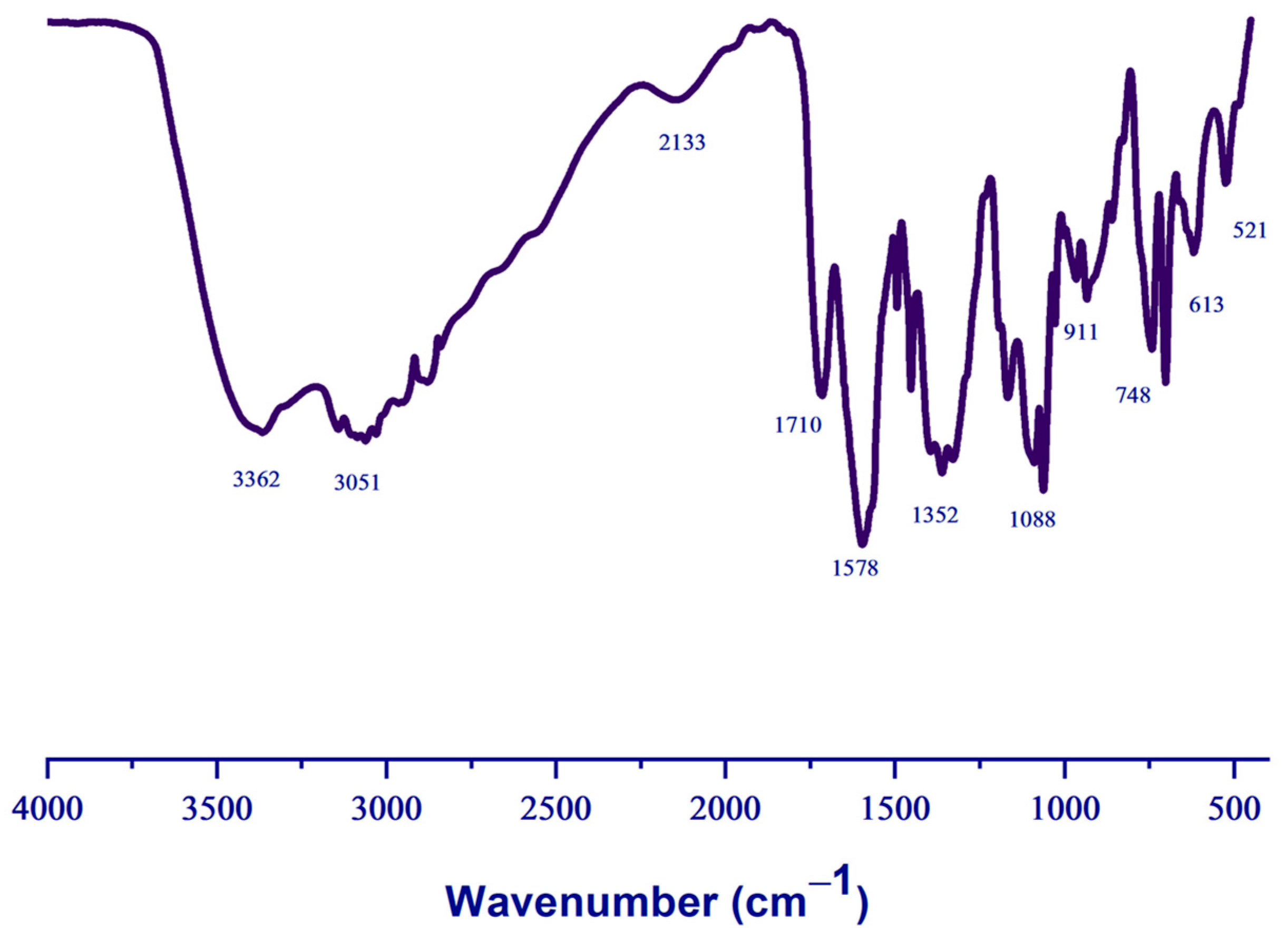

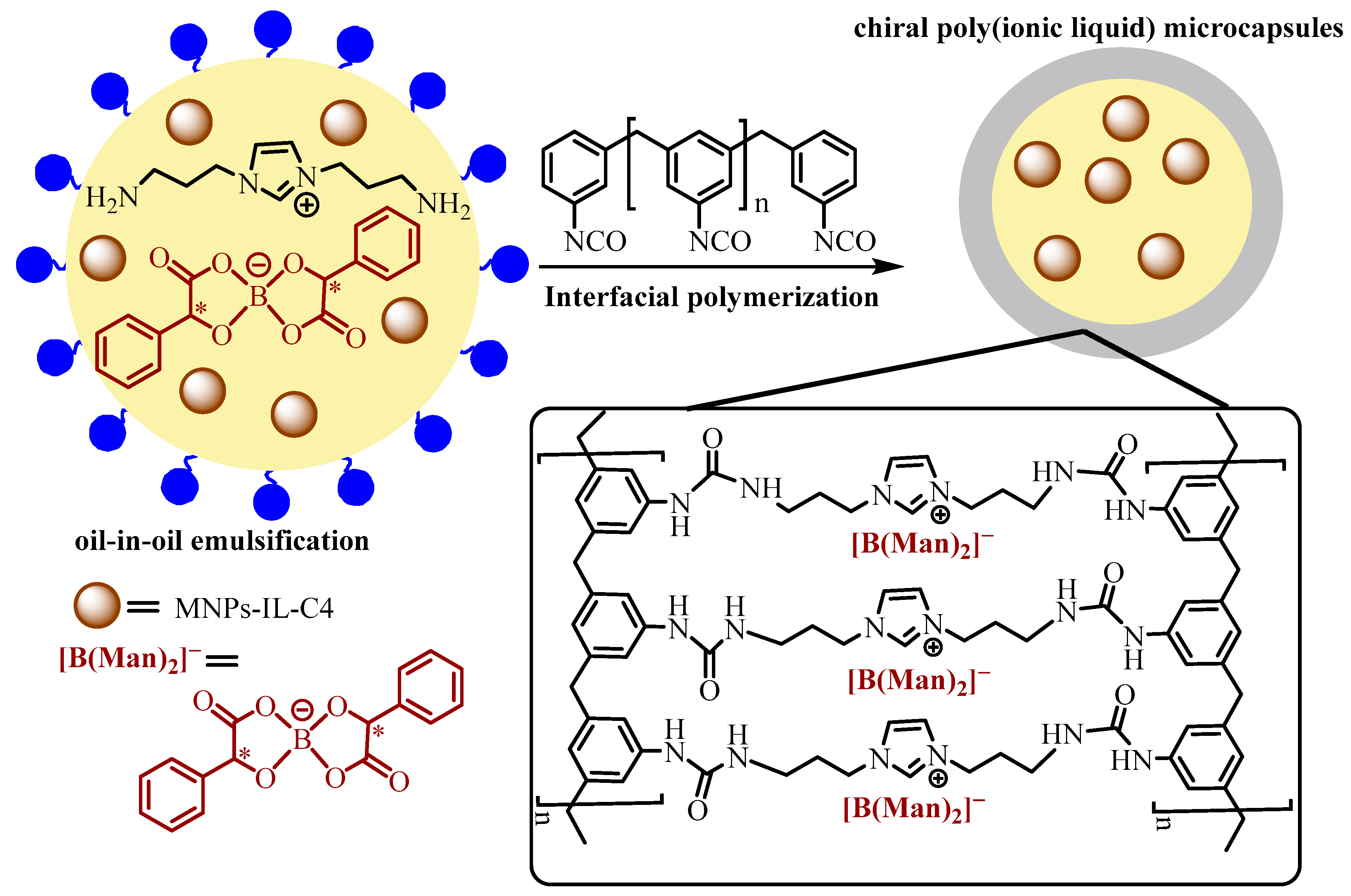
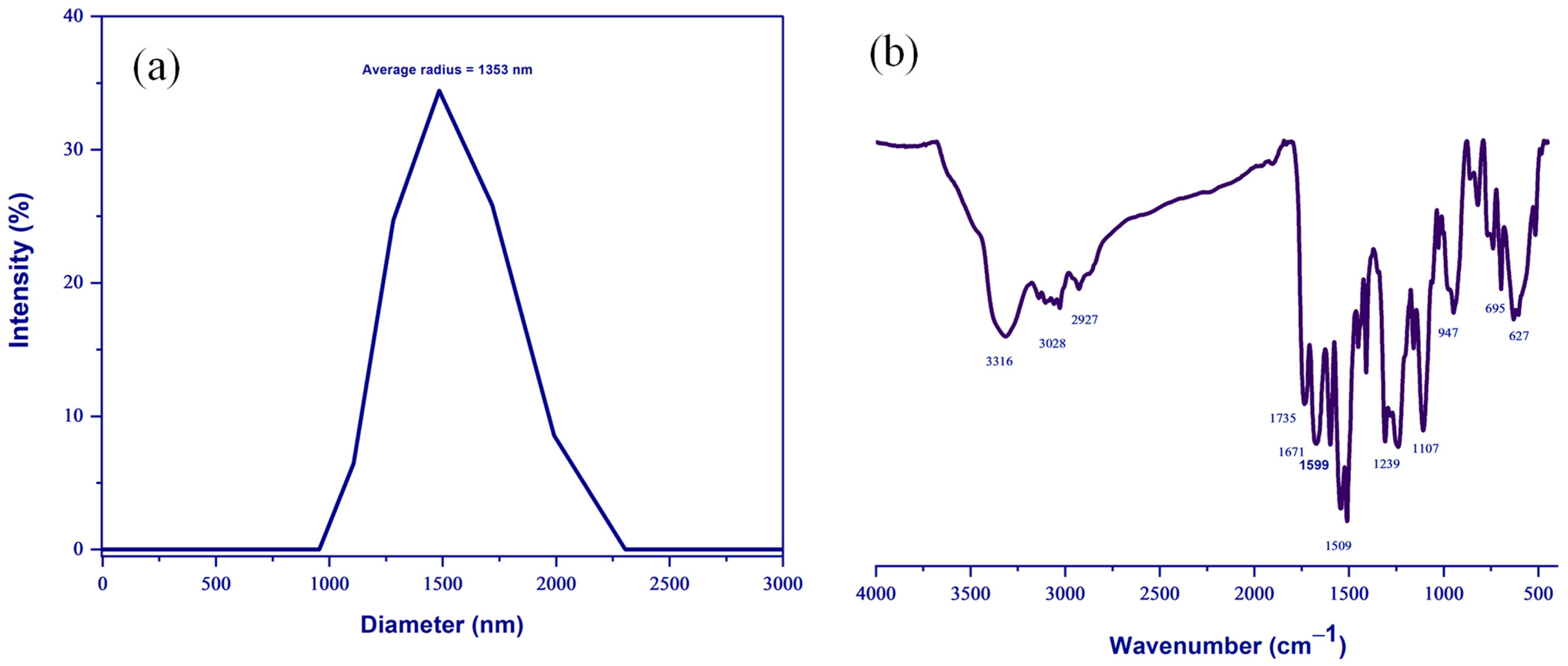

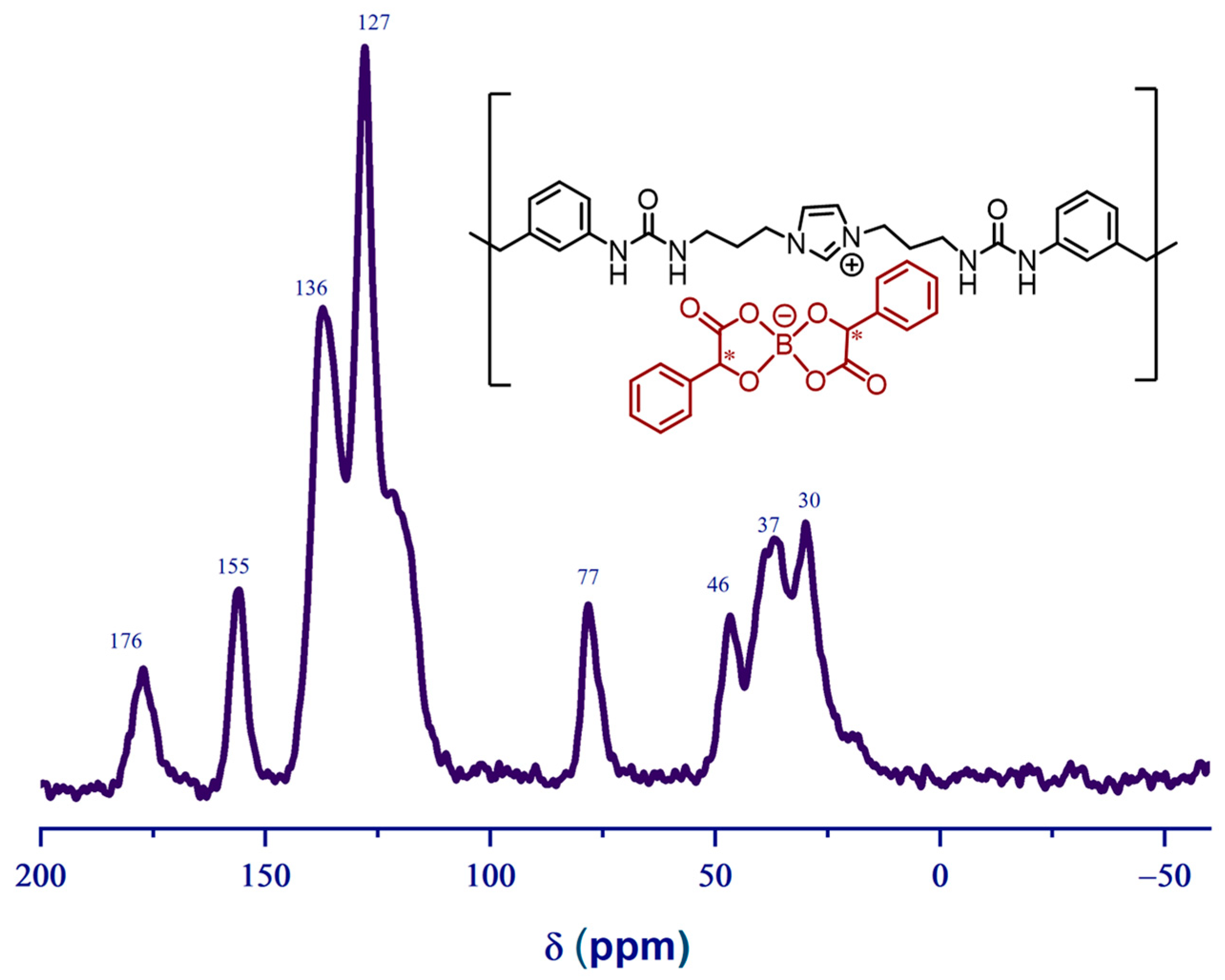
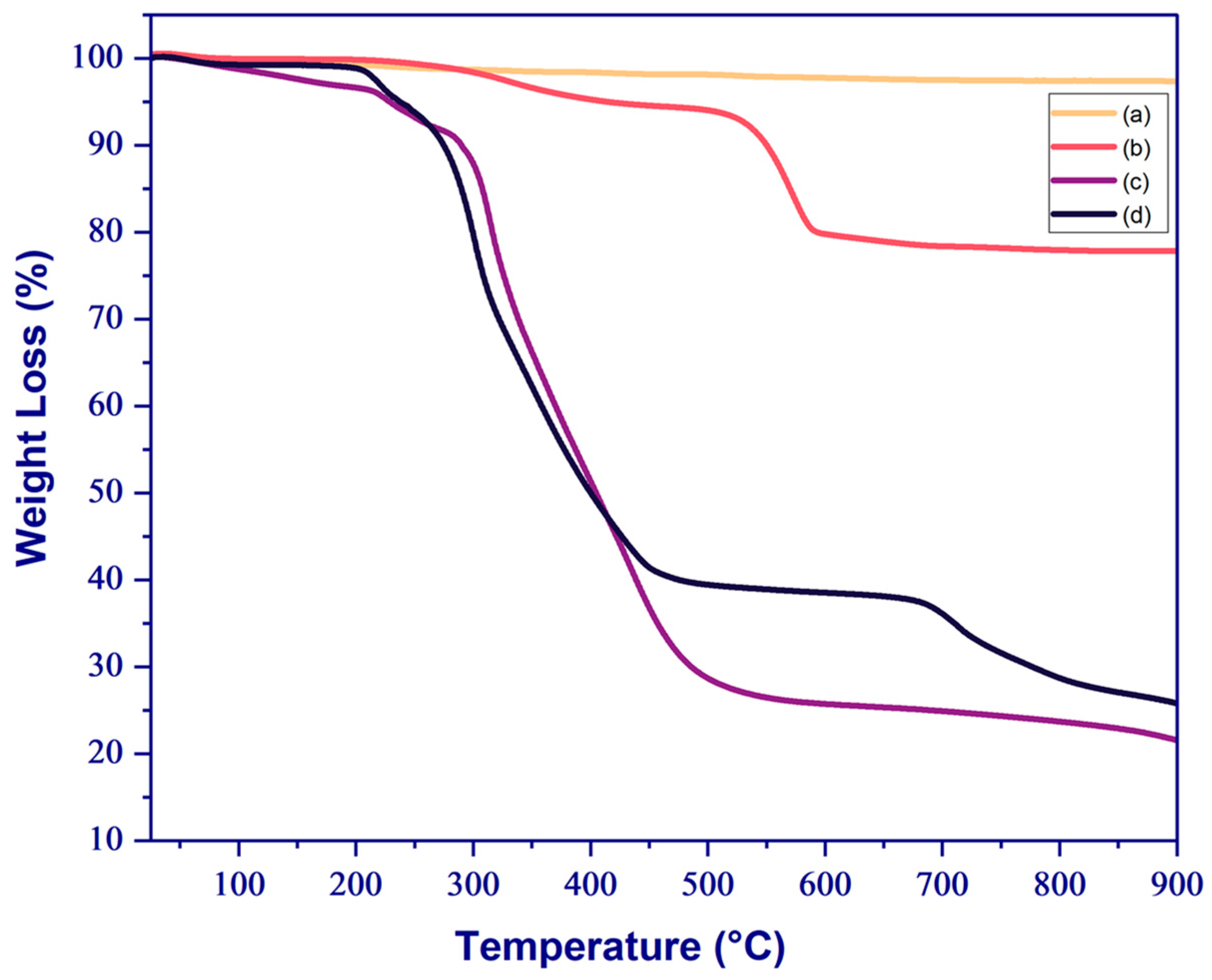
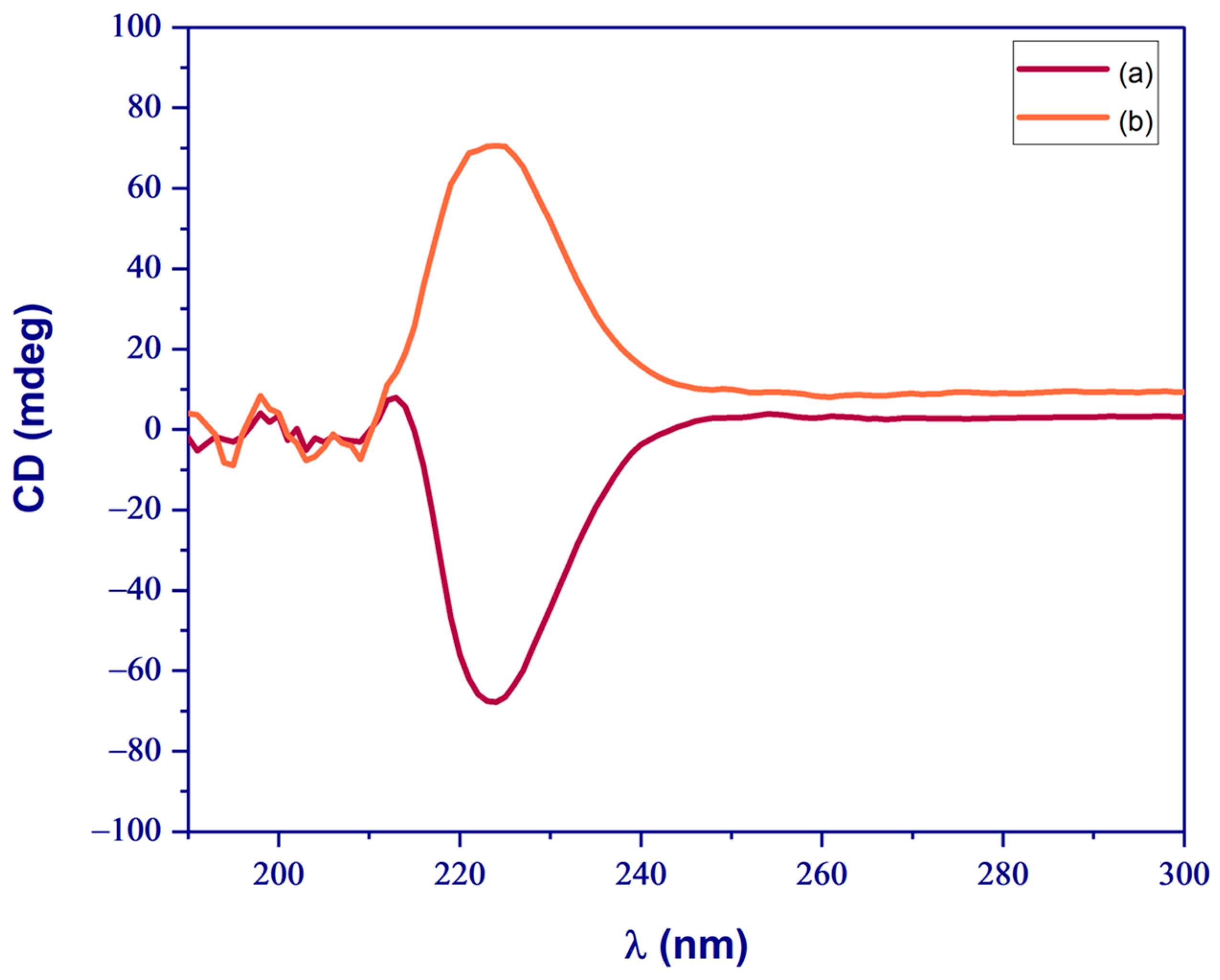



| Entry | Configuration of IL-NH2-BMB | Polar Solvent | MNPs-IL-C4 (mg) | TEM Images |
|---|---|---|---|---|
| 1 | R | DMSO | 0 | 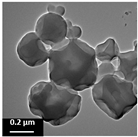 |
| 2 | R | DMSO | 20 | 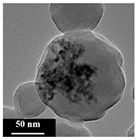 |
| 3 | R | DMSO | 40 | 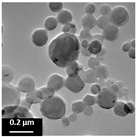 |
| 4 | R | DMSO | 80 |  |
| 5 | R | DMSO | 200 |  |
| 6 | S | DMSO | 200 | 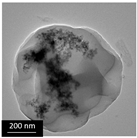 |
| 7 | R | DMF | 20 | 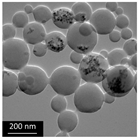 |
| 8 | R | DMF | 40 |  |
| 9 | R | DMF | 80 | 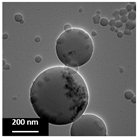 |
| 10 | R | DMAc | 20 | 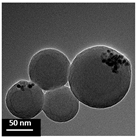 |
| 11 | R | DMAc | 40 |  |
| 12 | R | DMAc | 160 |  |
Disclaimer/Publisher’s Note: The statements, opinions and data contained in all publications are solely those of the individual author(s) and contributor(s) and not of MDPI and/or the editor(s). MDPI and/or the editor(s) disclaim responsibility for any injury to people or property resulting from any ideas, methods, instructions or products referred to in the content. |
© 2024 by the authors. Licensee MDPI, Basel, Switzerland. This article is an open access article distributed under the terms and conditions of the Creative Commons Attribution (CC BY) license (https://creativecommons.org/licenses/by/4.0/).
Share and Cite
Siam, R.; Ali, A.; Abu-Reziq, R. Magnetically Separable Chiral Poly(ionic liquid) Microcapsules Prepared Using Oil-in-Oil Emulsions. Polymers 2024, 16, 2728. https://doi.org/10.3390/polym16192728
Siam R, Ali A, Abu-Reziq R. Magnetically Separable Chiral Poly(ionic liquid) Microcapsules Prepared Using Oil-in-Oil Emulsions. Polymers. 2024; 16(19):2728. https://doi.org/10.3390/polym16192728
Chicago/Turabian StyleSiam, Reema, Abeer Ali, and Raed Abu-Reziq. 2024. "Magnetically Separable Chiral Poly(ionic liquid) Microcapsules Prepared Using Oil-in-Oil Emulsions" Polymers 16, no. 19: 2728. https://doi.org/10.3390/polym16192728







